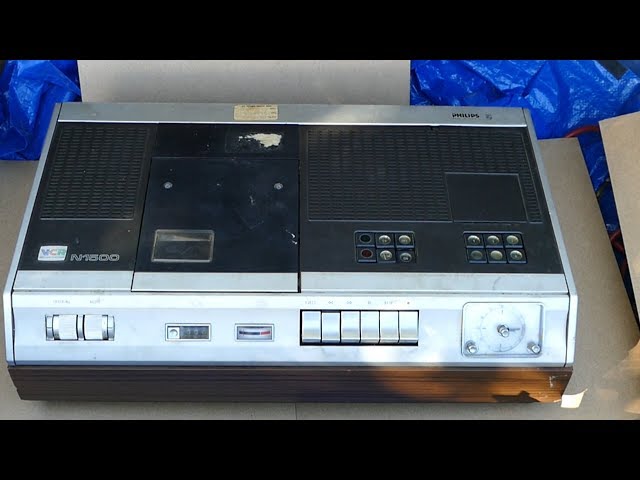The Philips N1500 was a popular VCR model in the mid-1990s that provided an easy way to both record and play back videos. This little black box was a staple in many living rooms at the time and allowed people to build home video libraries of their favorite movies and TV shows.
- To record, simply connect the N1500 to your TV’s antenna port and insert a blank VHS tape. You could then set the built-in tuner to the channel you wanted to record and press the red ‘Record’ button when your show started. The N1500 made it straightforward to schedule recordings in advance too using its on-screen menu and timer.
- For playback, just pop in a prerecorded movie and press ‘Play’. You had basic controls to stop, rewind, fast forward, and pause. The N1500 even had a jog dial to slowly advance frame by frame. An auto-tracking feature helped provide the best possible image quality by automatically adjusting the VCR’s recording and playback heads.
- The N1500 wasn’t perfect though. If you wanted to dub a copy of a tape or do any kind of editing, you were out of luck. It also lacked more advanced features like Dolby noise reduction that were found on higher-end models. But for simply recording shows to watch later and enjoying the occasional movie night, the Philips N1500 VCR got the job done and then some.
You can buy it from EBAY using the link Below:
Key Features and Specifications of the Philips N1500 VCR
Below are the key features of the Philips N1500 VCR:
1. Impressive Recording Capacity
For its era, the N1500 offered an incredible 14 hours of recording time on a single T-240 VHS tape in SP mode. This was thanks to its two-head helical scan recording system. Compared to most other models on the market at the time which could only hold 6-8 hours per tape, the N1500’s capacity seemed mammoth.
2. High-Tech Features
The N1500 incorporated several forward-thinking features. It had an on-screen display that showed information like the current channel, time counter, and tape speed. It was also one of the first VCRs with index search, allowing you to mark spots on the tape so you could quickly find them later. An RF input let you connect an antenna to receive over-the-air TV signals.
3. Simple, Functional Design
This VCR was designed to be easy to operate. Large, clearly labeled buttons controlled all major functions. A jog shuttle knob made it simple to move rapidly through recorded content. The N1500’s minimal, rectangular case looked right at home next to TVs of that era, with its matte black finish and small blue display.
Setting Up and Using the VCR
Setting up your Philips N1500 is pretty straightforward. First, find a good spot for it, you’ll want it near your TV, cable box, and any devices you plan to connect. Make sure there’s an outlet nearby for power.
Once you have a spot, you can connect the necessary cables. The VCR has inputs for cable, an antenna, and auxiliary devices like a camcorder. It also has outputs to connect to your TV for video and audio. Connect the included RF cable from the VCR’s output to your TV’s antenna input. Then connect your cable or antenna to the appropriate VCR input.
Next, turn everything on and tune your TV to channel 3 or 4, depending on what the VCR is set to. You may need to go into your TV’s menu to add ‘external input’ as a source. Select that input and you should see the VCR’s menu on screen. Use the VCR’s channel +/- buttons to tune to the channel with your cable or antenna signal.
Picture and Sound Quality of the Philips N1500 VCR
Below are the Picture and Sound Quality of the Philips N1500 VCR:
1. Picture Quality
The N1500 could record and playback video in SP, LP, and EP speeds. At the SP speed, the picture was very sharp and clear. The colors were vibrant and lifelike. The LP and EP speeds showed some degradation in quality, with the EP speed being quite fuzzy but still watchable. For most casual viewing and time-shifting of shows to watch later, the SP and LP speeds were perfectly suitable.
The N1500’s video heads were made of quality materials and the build quality helped produce a steady, jitter-free image. The N1500 was also able to handle various tape types like T120, T160, and T180, giving you options for recording length versus quality. Using a T120 or T160 tape helped maximize picture quality at the SP and LP speeds.
2. Sound Quality
The N1500 recorded mono sound but was able to play back both mono and stereo audio. The mono recording and playback were decent, with voices coming through clearly. The stereo playback was able to produce full, balanced sound for most TVs of the era. Volume levels were adjustable using the VCR’s front panel buttons or the remote control.
For connecting to your TV, the N1500 had basic composite video and RCA audio outputs. It didn’t have S-Video or component video outputs, but the composite video signal was still able to provide a pretty clean image for most CRT TVs. The RCA audio outputs allowed for connecting to your TV’s mono or stereo inputs.
READ ALSO- The Victrola Record Player Review
Conclusion
While obviously outdated today, for its time the Philips N1500’s picture and sound quality were quite solid and capable. It provided a reliable, user-friendly way for people to time-shift their favorite shows and movies, all with video and audio that was satisfying for most casual viewing needs. For nostalgic retro appeal, popping in an old tape and watching it on a CRT TV can be a fun blast from the past!
